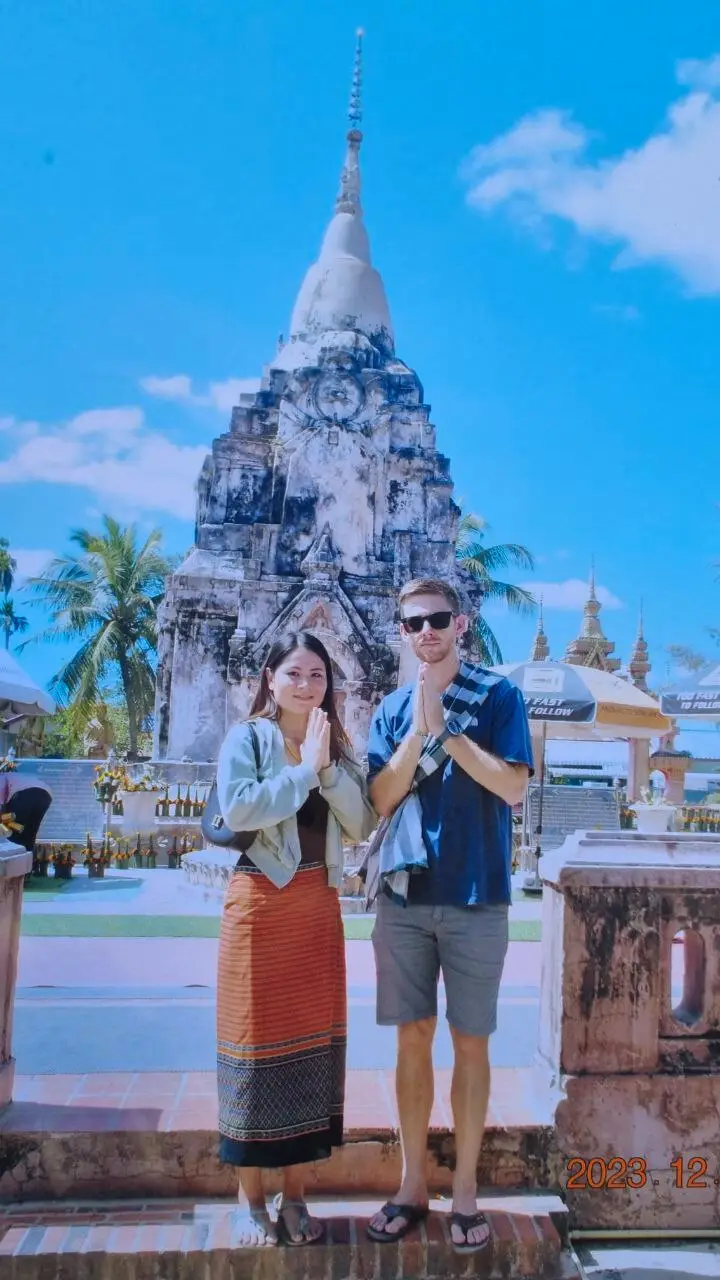
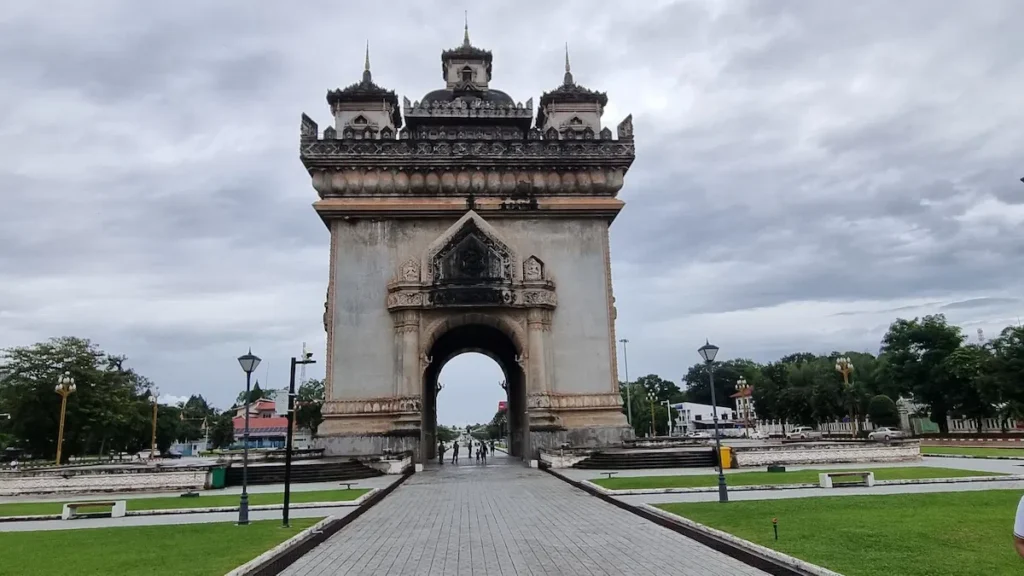
The Patuxai Victory Monument (also known as Patuxay or Victory Gate) is one of the most iconic landmarks in Vientiane, Laos — a towering archway which blends French colonial influence with rich Laotian symbolism. Often compared to the Arc de Triomphe in Paris, France, Patuxai stands as a proud reminder of Laos’ turbulent past and resilient national identity. Located in the heart of the capital on Lane Xang Avenue, this impressive structure honors those who fought for independence from French colonial rule.
Today, the Patuxai Monument isn’t just a historical relic; it’s a living symbol of unity, peace, and Lao pride. Surrounded by manicured gardens, lotus ponds, and a musical fountain, it attracts both tourists and locals who come to admire its architecture, enjoy panoramic views of Vientiane from the top, or simply relax in the nearby park.
Whether you’re planning a visit to Vientiane, exploring Lao culture, or searching for the best things to do in Laos, this complete guide to the Patuxai Victory Monument will provide everything you need to know — from its fascinating history and symbolic architecture to practical visitor tips and why it deserves a spot on your itinerary.
The Patuxai Victory Monument was constructed between 1957 and 1968, during a time when Laos was emerging from French colonial rule and grappling with its national identity. Funded by the United States through foreign aid intended for a new airport runway, the Laotian government instead repurposed the cement to build this symbolic structure — giving rise to the nickname “the vertical runway.”
The current name Patuxai comes from the ancient Sanskrit words patu (door or gate) and jaya (victory), literally meaning “Victory Gate.” Designed by Lao architect Tham Sayasithsena, Patuxai was inspired by the Arc de Triomphe in Paris, but infused with uniquely Lao elements — including mythical creatures, lotus motifs and traditional religious symbols. The five towers of the monument represent the five principles of peaceful coexistence in Buddhism and Lao culture: thoughtful behavior, flexibility, honesty, honor and prosperity.
Although construction was never fully completed due to political instability and funding issues, Patuxai quickly became a national symbol. Originally named Anousavali (Monument), it was renamed “Patuxai” after the communist Pathet Lao came to power in 1975, marking a new era of national pride and independence. Over the decades, the monument has grown from an unfinished wartime project into a cherished landmark that represents the strength, resilience, and cultural identity of the Lao people.
The Patuxai Victory Monument may resemble the Arc de Triomphe in Paris at first glance, but a closer look reveals a deeply Laotian soul embedded in every detail. Built in a reinforced concrete structure, the monument is richly decorated with traditional Lao motifs, such as mythical kinnari, multi-headed nagas, and Dok Champa (frangipani) flowers, the national symbol of Laos. These decorations turn what might have been just a copy of Western design into something special and truly Lao.
Unlike the French version, Patuxai has five beautifully designed towers. They are inspired by the shape of a Buddhist stupa and stand for five important values in Buddhism, like peace, honesty, and respect. At the top, the central viewing tower offers panoramic views over Vientiane, including sights of That Luang, Lane Xang Avenue, and the surrounding gardens. Inside, the monument features spiral staircases, murals of gods and warriors, and interior arches symbolizing protection and spiritual harmony.
The blend of French neoclassical form and Lao spiritual symbolism was a deliberate choice — a way to reflect the country’s complex colonial past while asserting its cultural independence. Even the unfinished concrete ceiling in parts of the monument is often interpreted as a raw, honest reminder of a country in transition — not yet perfect, but moving forward.
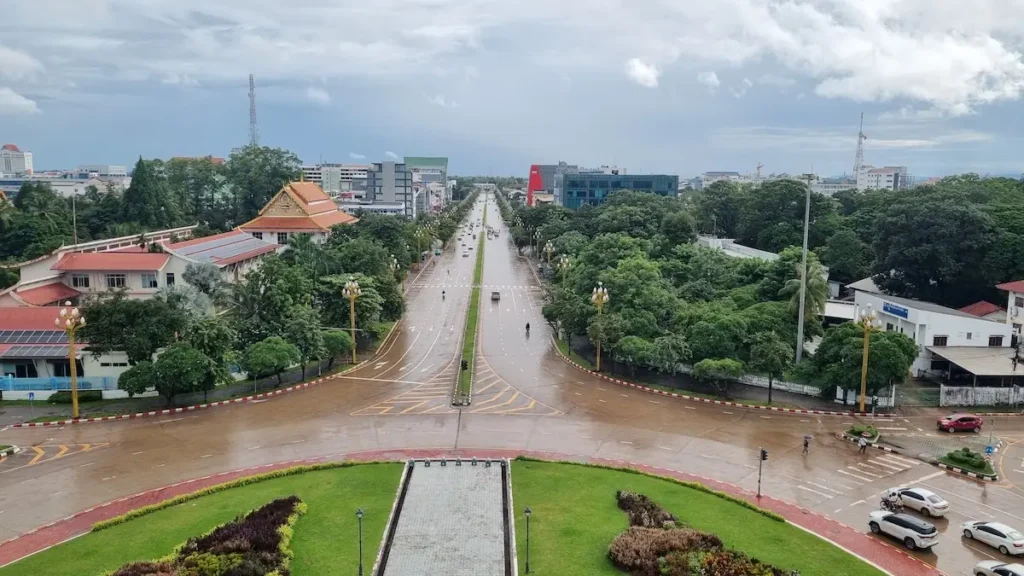
A visit to the Patuxai Victory Monument is more than just looking at it from the outside — you can actually go inside and explore several levels. On the ground floor, you’ll find small souvenir kiosks selling local crafts and gifts. As you climb the spiral staircases, the next level reveals a modest exhibition area and interior walls decorated with murals of gods, elephants, and traditional Lao patterns. At the very top, the viewing deck offers sweeping 360-degree views over Vientiane, including That Luang, Lane Xang Avenue, and the city’s low-rise skyline.
Outside, the Patuxai Park creates a calm space in the heart of the capital. The area around the monument is beautifully landscaped with lotus ponds, shady trees, and benches where locals relax in the evenings. A Chinese-donated musical fountain often plays at night, adding a peaceful ambiance to the surroundings. Locals come here for photos, evening walks, or to sit with friends, making the monument not just a tourist attraction, but a real part of everyday life in Vientiane.
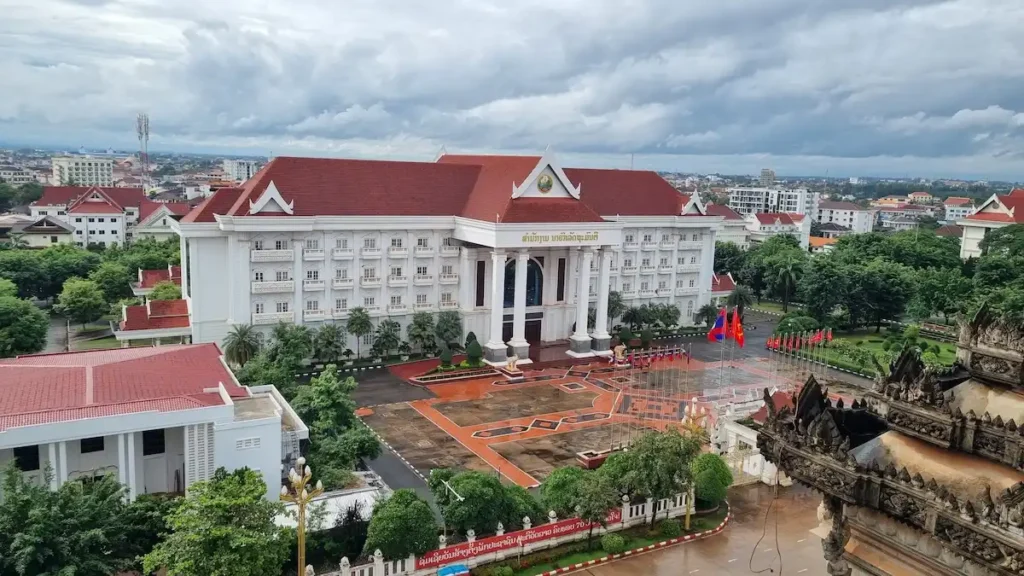

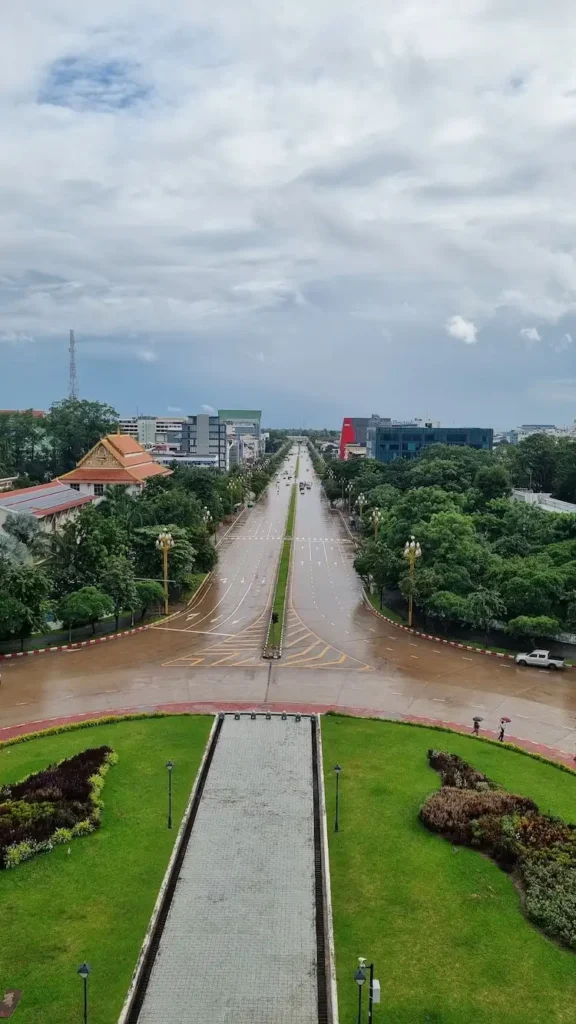

Vientiane is the laid-back capital of Laos — a mix of colonial charm, Buddhist temples, and riverfront cafés. While it may not have the high energy of other Southeast Asian capitals, it’s a great place to slow down, explore local culture and enjoy Lao hospitality. From budget guesthouses to boutique hotels and upscale riverside stays, Vientiane offers something for every type of traveler. Some areas are livelier than others, so if you prefer peace and quiet, it’s worth checking the location before booking. Here are some recommended places to stay in Vientiane.
👉 sPark Design Hotel: This is our preferred choice whenever we visit Vientiane. It is just a few minutes driving away from the heart of town, close to the mekong river, located in a quiet alley. The hotel has a gym, swimming pool and rooftop bar. Prices ranging from 20-30 USD. Highly recommended when staying in Vientiane.
👉 The Riva Hotel Vientiane: This one is a stylish boutique hotel just a short walk from the Mekong River and Vientiane’s main attractions. With modern rooms, friendly staff, and a peaceful location, it’s a great choice for couples or solo travelers looking for comfort and convenience in the capital.
👉 Peaceful Hotel lives up to its name, offering a quiet and comfortable stay slightly away from the city buzz. With spacious, modern rooms and helpful staff, it’s a great mid-range option for travelers who want a calm atmosphere but still easy access to Vientiane’s main attractions.
👉 Panda Hostel Vientiane: Panda Hostel is a budget-friendly and social spot in the heart of Vientiane, perfect for backpackers and solo travelers. It offers clean dorms, private rooms, and a relaxed common area — ideal for meeting other travelers while staying close to the city’s main sights.
The Patuxai Victory Monument is more than just a striking landmark in Vientiane, it’s a symbol of Laos’ journey to independence, a blend of cultural pride and spiritual values, and a reflection of the nation’s resilience through change. With its unique mix of French-inspired architecture and deeply Laotian symbolism, Patuxai tells a story you won’t find in any textbook.
Whether you’re climbing to the top for panoramic views, admiring the intricate carvings, or relaxing in the peaceful park below, a visit to Patuxai offers both historical insight and a connection to modern Lao identity. It’s a must-see for anyone wanting to understand the heart of Vientiane — and the spirit of Laos itself. The monument is located in the heart of the city, so it is hard to miss anyway.